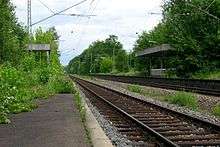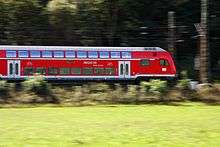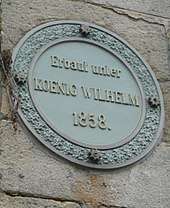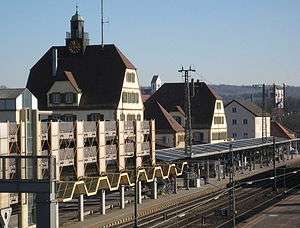Plochingen–Tübingen railway
The Plochingen–Tübingen railway forms part of the main line from Stuttgart via Reutlingen to Tübingen in the German state of Baden-Württemberg, which is known as the Neckar-Alb-Bahn ("Neckar-Alb Railway") (KBS 760). It largely follows the meandering course of the Neckar river, but, between Nürtingen and Tübingen the line runs through the Swabian Alps. Between Stuttgart and Plochingen the line runs parallel to the Fils Valley Railway, trains on this section also sometimes use the Fils Valley line tracks. The line is fully electrified and double track throughout. Interchange is possible between Plochingen and Tübingen in Wendlingen am Neckar, Nürtingen, Metzingen and Reutlingen. There are level crossings in Wendlingen, Oberboihingen and Wannweil. There are three crossings in Oberboihingen, including two which can be manually operated by a gatekeeper, the only ones in Germany.
| Plochingen–Tübingen railway | ||||||||||||||||||||||||||||||||||||||||||||||||||||||||||||||||||||||||||||||||||||||||||||||||||||||||||||||||||||||||||||||||||||||||||||||||||||||||||||||||||||||||||||||||||||||||||||||||||||||||||||||||||||||||||||||||||||||||||||||||||||||||||||||||||||||||||||||||||||||||||||||||||||||||||||||||||||||||||||||||||||||||
|---|---|---|---|---|---|---|---|---|---|---|---|---|---|---|---|---|---|---|---|---|---|---|---|---|---|---|---|---|---|---|---|---|---|---|---|---|---|---|---|---|---|---|---|---|---|---|---|---|---|---|---|---|---|---|---|---|---|---|---|---|---|---|---|---|---|---|---|---|---|---|---|---|---|---|---|---|---|---|---|---|---|---|---|---|---|---|---|---|---|---|---|---|---|---|---|---|---|---|---|---|---|---|---|---|---|---|---|---|---|---|---|---|---|---|---|---|---|---|---|---|---|---|---|---|---|---|---|---|---|---|---|---|---|---|---|---|---|---|---|---|---|---|---|---|---|---|---|---|---|---|---|---|---|---|---|---|---|---|---|---|---|---|---|---|---|---|---|---|---|---|---|---|---|---|---|---|---|---|---|---|---|---|---|---|---|---|---|---|---|---|---|---|---|---|---|---|---|---|---|---|---|---|---|---|---|---|---|---|---|---|---|---|---|---|---|---|---|---|---|---|---|---|---|---|---|---|---|---|---|---|---|---|---|---|---|---|---|---|---|---|---|---|---|---|---|---|---|---|---|---|---|---|---|---|---|---|---|---|---|---|---|---|---|---|---|---|---|---|---|---|---|---|---|---|---|---|---|---|---|---|---|---|---|---|---|---|---|---|---|---|---|---|---|---|---|---|---|---|---|---|---|---|---|---|---|---|---|---|---|---|---|---|---|---|---|---|---|---|---|---|---|---|---|---|---|---|---|---|
| Overview | ||||||||||||||||||||||||||||||||||||||||||||||||||||||||||||||||||||||||||||||||||||||||||||||||||||||||||||||||||||||||||||||||||||||||||||||||||||||||||||||||||||||||||||||||||||||||||||||||||||||||||||||||||||||||||||||||||||||||||||||||||||||||||||||||||||||||||||||||||||||||||||||||||||||||||||||||||||||||||||||||||||||||
| Locale | Lower Saxony, Germany | |||||||||||||||||||||||||||||||||||||||||||||||||||||||||||||||||||||||||||||||||||||||||||||||||||||||||||||||||||||||||||||||||||||||||||||||||||||||||||||||||||||||||||||||||||||||||||||||||||||||||||||||||||||||||||||||||||||||||||||||||||||||||||||||||||||||||||||||||||||||||||||||||||||||||||||||||||||||||||||||||||||||
| Line number |
| |||||||||||||||||||||||||||||||||||||||||||||||||||||||||||||||||||||||||||||||||||||||||||||||||||||||||||||||||||||||||||||||||||||||||||||||||||||||||||||||||||||||||||||||||||||||||||||||||||||||||||||||||||||||||||||||||||||||||||||||||||||||||||||||||||||||||||||||||||||||||||||||||||||||||||||||||||||||||||||||||||||||
| Technical | ||||||||||||||||||||||||||||||||||||||||||||||||||||||||||||||||||||||||||||||||||||||||||||||||||||||||||||||||||||||||||||||||||||||||||||||||||||||||||||||||||||||||||||||||||||||||||||||||||||||||||||||||||||||||||||||||||||||||||||||||||||||||||||||||||||||||||||||||||||||||||||||||||||||||||||||||||||||||||||||||||||||||
| Line length | 71.0 km (44.1 mi) | |||||||||||||||||||||||||||||||||||||||||||||||||||||||||||||||||||||||||||||||||||||||||||||||||||||||||||||||||||||||||||||||||||||||||||||||||||||||||||||||||||||||||||||||||||||||||||||||||||||||||||||||||||||||||||||||||||||||||||||||||||||||||||||||||||||||||||||||||||||||||||||||||||||||||||||||||||||||||||||||||||||||
| Number of tracks | 2 (throughout) | |||||||||||||||||||||||||||||||||||||||||||||||||||||||||||||||||||||||||||||||||||||||||||||||||||||||||||||||||||||||||||||||||||||||||||||||||||||||||||||||||||||||||||||||||||||||||||||||||||||||||||||||||||||||||||||||||||||||||||||||||||||||||||||||||||||||||||||||||||||||||||||||||||||||||||||||||||||||||||||||||||||||
| Track gauge | 1,435 mm (4 ft 8 1⁄2 in) standard gauge | |||||||||||||||||||||||||||||||||||||||||||||||||||||||||||||||||||||||||||||||||||||||||||||||||||||||||||||||||||||||||||||||||||||||||||||||||||||||||||||||||||||||||||||||||||||||||||||||||||||||||||||||||||||||||||||||||||||||||||||||||||||||||||||||||||||||||||||||||||||||||||||||||||||||||||||||||||||||||||||||||||||||
| Electrification | 15 kV/16.7 Hz AC overhead catenary | |||||||||||||||||||||||||||||||||||||||||||||||||||||||||||||||||||||||||||||||||||||||||||||||||||||||||||||||||||||||||||||||||||||||||||||||||||||||||||||||||||||||||||||||||||||||||||||||||||||||||||||||||||||||||||||||||||||||||||||||||||||||||||||||||||||||||||||||||||||||||||||||||||||||||||||||||||||||||||||||||||||||
| Route number |
| |||||||||||||||||||||||||||||||||||||||||||||||||||||||||||||||||||||||||||||||||||||||||||||||||||||||||||||||||||||||||||||||||||||||||||||||||||||||||||||||||||||||||||||||||||||||||||||||||||||||||||||||||||||||||||||||||||||||||||||||||||||||||||||||||||||||||||||||||||||||||||||||||||||||||||||||||||||||||||||||||||||||
| ||||||||||||||||||||||||||||||||||||||||||||||||||||||||||||||||||||||||||||||||||||||||||||||||||||||||||||||||||||||||||||||||||||||||||||||||||||||||||||||||||||||||||||||||||||||||||||||||||||||||||||||||||||||||||||||||||||||||||||||||||||||||||||||||||||||||||||||||||||||||||||||||||||||||||||||||||||||||||||||||||||||||
History
The first section of the Plochingen–Tübingen opened in 1859 between Plochingen (which had been connected to Stuttgart by the Württemberg Central Railway, now the Fils Valley Railway, since 1846) and Reutlingen by the Royal Württemberg State Railways. In 1861 the Upper Neckar line was extended via Tübingen to Rottenburg. The line was extended to Eyach (1864) and Horb am Neckar (1866) and eventually reached Immendingen in 1870. The line towards Horb from Tübingen is still known as the Upper Neckar Railway, but there are only a few through trains running on both sections of the line.
As early as 1888 the line was duplicated to Tübingen and the line was electrified by 1 October 1934. Neither upgrade have yet been carried out on the line towards Horb.
The former stations of Bempflingen, Betzingen and Kirchentellinsfurt have been reduced in status to halts (Haltepunkten, that is they do not have sets of points) in the second half of the 20th century. In addition, between Plochingen and Tübingen many sidings and freight yards have been abandoned.
Current operations
A dense network of regional trains, including Interregio-Express services, connect the Neckar-Alb region with the transportat hub of Stuttgart Hauptbahnhof. The line is operated by DB ZugBus Regionalverkehr Alb-Bodensee (RAB), a subsidiary of Deutsche Bahn.
Signalling on the Plochingen-Wendlingen section is control by an electronic interlocking in Plochingen, itself controlled from the operations centre in Karlsruhe. There is also an electronic signal box in Reutlingen in operation. Otherwise, signalling in controlled by relay interlockings.
S-Bahn
Between Stuttgart and Kirchheim unter Teck S-Bahn services on line S1 of the Stuttgart S-Bahn run on the tracks of the Neckar-Alb Railway. This line passes through Plochingen, Wernau, Wendlingen am Neckar, Kirchheim (Teck)-Ötlingen to Kirchheim unter Teck.
Regionalbahn

Regionalbahn (RB) services run from Monday to Friday between Plochingen and Tübingen every hour, from Metzingen to Reutlingen every half-hour and every half-hour to Tübingen in the peak hour. On weekends, RB services run every two hours; on Saturday mornings there are additional services between and Metzingen and Tübingen. Nearly all regional services continue from Tübingen on the Ammer Valley Railway to Herrenberg. Almost all RB services are formed of class 650 diesel multiple units.
Regional Express


Regional-Express (RE) services run on the line every hour and every half-hour in peak hours. Almost all RE are services are hauled by class 143 locomotives. There are two services each way with old double-deck carriages (with green seats and no air conditioning), three services, each with five double-deck carriages (with air conditioning and LED lighting) delivered in 2008 and one service with five refurbished Silberling carriages plus a control car in both the morning and afternoon rush hour.
The last pair of trains to and from Tübingen is usually operated with class 611 diesel multiple units. The RE trains between Stuttgart Hauptbahnhof and Tübingen Hauptbahnhof stop in Stuttgart-Bad Cannstatt, Esslingen, Plochingen, Wendlingen, Nürtingen, Metzingen and Reutlingen Hauptbahnhof. The extra peak services also stop in Wernau.
Interregio-Express
Between Tübingen and Stuttgart an Interregio-Express (IRE) service operated every two hours with only one stop in Reutlingen. Almost all of the IRE services are operated with class 612 diesel multiple units. In peak hours there are additional IRE services operated with locomotive-hauled trains. These use a class 110 electric locomotive hauling three Silberling carriages and a driving trailer.
Long distance
Since the timetable change in December 2009, the Neckar-Alb Railway is also served by long distance services. From Mondays to Fridays an InterCity service runs at 06:11 from Tübingen with stops in Reutlingen, Metzingen and Nürtingen and Plochingen via Stuttgart to Düsseldorf and Berlin. Services to Düsseldorf (IC 2010) and Berlin (IC 2011) reach their destinations in the evening and IC 1915 reaches Tübingen, from Mondays to Thursdays, at 19:50, and, on Sundays, at 21:50.[2] This link is a trial limited to two years.
Freight
During Deutsche Bahn’s “market-oriented freight supply” reform program (MORA C), Hohenzollerische Landesbahn (HzL) took over all freight transport between Tübingen and Plochingen, previously operated by Railion, in 2002. Despite considerable demand, HzL retired from this business after several years of disagreement over the access charges incurred for its services. Since then, the Tübingen freight yard is only regularly served towards the west, with a few exceptions, such as for the storage of track maintenance trains.
The only regular freight runs between Plochingen and Wendlingen am Neckar (and from there via the Teck Railway to Oberlenningen) and between Plochingen and Nürtingen (and from there via the Täles Railway to Neuffen). Freight also runs from Plochingen to Metzingen (from there on the Erms Valley Railway via Dettingen an der Erms to Bad Urach). Plans to transport waste from the districts of Tübingen and Reutlingen to the Stuttgart-Münster Incinerator by rail have been abandoned.
The city of Reutlingen has secured the site of the former freight depot so that a container terminal can be built there.[3]
Because of the temporary closure of the Rhine Valley Railway in 2017 due to the collapse of the Rastatt Tunnel, many freight trains were diverted via Tübingen–Horb and some regional trains were cancelled.
Rollingstock
- IRE: trains hauled by class 612 locomotives (Aulendorf–Stuttgart, Rottenburg–Stuttgart), class 110 locomotives + four Silberling carriages (only between Tübingen and Stuttgart)
- RE: class 143 locomotives or class 111 locomotives with five double-deck carriages and a class 612 hauled train
- RB: class 650 diesel multiple units (Herrenberg–Plochingen, Herrenberg–Bad Urach), one service operated with class 110 locomotives + Silberling carriages (Plochingen–Tübingen) and class 426 electric multiple units (Plochingen–Nürtingen)
Planning
For several years discussion have been under way on plans to integrate the Plochingen–Wendlingen–Nürtingen–Reutlingen–Tübingen line together with other regional lines (Ammer Valley Railway, Erms Valley Railway, Swabian Alb Railway, Zollernalb Railway and the Upper Neckar Railway) into the Neckar-Alb Regional Stadtbahn on the Karlsruhe model.
As part of Stuttgart 21, it is planned to connect the Neckar-Alb Railway via the Little Wendlingen Curve (Kleine Wendlinger Kurve) to the Wendlingen–Ulm high-speed railway. This will cut travel times from Tübingen to Stuttgart Flughafen/Messe station at Stuttgart Airport in half and reduce travel time to the Stuttgart Hauptbahnhof by 4 minutes.[4]
From 2020 on, Abellio will operate the services between Stuttgart and Tübingen with slower services only between Wendlingen and Reutlingen.
Fare zones
Between Stuttgart Hauptbahnhof and Bempflingen, fares on the line runs are coordinated by the Transport and Tariff Association of Stuttgart (Verkehrs- und Tarifverbund Stuttgart, VVS). Between Bempflingen and Tübingen, they are coordinated by the Neckar-Alb-Danube Transport Association (Verkehrsverbund Neckar-Alb-Donau, Naldo).
References
Footnotes
- Eisenbahnatlas Deutschland (German railway atlas). Schweers + Wall. 2009. pp. 94, 104. ISBN 978-3-89494-139-0.
- Schnuppern bei IC-Verbindung, accessed 24 March 2011
- http://agmannheim.de/servlet/PB/menu/1240974/index.html?ROOT=1153033
- www.das-neue-herz-europas.de
Sources
- Reichhold, Dieter (2010). Obere Neckarbahn : eine Zeitreise auf der Strecke Plochingen, Wendlingen, Nürtingen, Metzingen, Reutlingen (in German) (1 ed.). Münsingen-Rietheim: Wiedemann. ISBN 978-3-941453-09-8.
External links
- "1944 timetable" (in German). Retrieved 13 March 2011.
